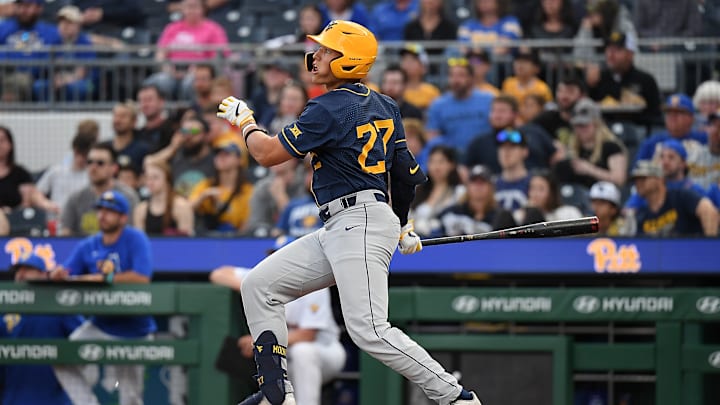1. SS JJ Wetherholt, West Virginia

JJ Wetherholt is a savvy left-handed hitter with exceptional contact and plate discipline skills. In 36 games this season for the West Virginia Mountaineers, he slashed .331/.472/.589. Wetherholt missed seven weeks early in the season due to a hamstring injury, which is the sole reason for his draft stock declining and even being a possibility at pick 7.
I briefly discussed consensus top 2 draft prospect Travis Bazzana earlier in the article, mentioning how he "has one of the most well-rounded offensive skillsets in the draft class". Wetherholt is right there with him, and it's wild how close these two are in terms of batted ball data, contact rate, and plate discipline.
SS JJ Wetherholt
AvgEV: 95.4 mph
90thEV: 108.2 mph
HardHit%: 57.1%
Barrel%: 31.2%
Contact%: 84.7%
Chase%: 14.1%
Z-Swing% 69.0%
2B Travis Bazzana
AvgEV: 95.9 mph
90thEV: 108.7 mph
HardHit%: 68.5%
Barrel%: 41.5%
Contact%: 85.1%
Chase%: 14.0%
Z-Swing%: 61.0%
HE IS SO BACK!!
— WVU Baseball (@WVUBaseball) April 25, 2023
GRAND SLAM JJ WETHERHOLT!!!#HailWV | @jj_wetherholt pic.twitter.com/6Ueu0WQwN2
Bazzana projects to hit for more power than Wetherholt due to hitting the barrel more consistently and pulling his aerial contact more often. Still, the offensive profiles are extremely similar, and Wetherholt handled his own at a more premium defensive position.
Hit: Wetherholt has an elite hit tool, making contact 88.5% of the time in the zone and 85.1% overall. Over the past two seasons for West Virginia, he struck out 39 times and drew 56 walks in 432 plate appearances. Wetherholt rarely expands the zone, chasing only 14.1% of the time while maintaining a decent zone swing rate. He genuinely has outstanding plate discipline skills rather than just benefiting from a passive approach at the plate. When Wetherholt makes contact, he possesses a sweet left-handed swing that generates tons of line drives to all fields.
JJ JUST HIT A BALL ONTO THE ROOF OF THE CLUBHOUSE ‼ pic.twitter.com/GSZO4Gm77i
— WVU Baseball (@WVUBaseball) May 9, 2024
Power: Wetherholt's power tool is certainly not his calling card; however, he still has above-average raw power. His 90th percentile exit velocity of 108.1 mph is in great territory. Wetherholt doesn't barrel or pull the ball enough to consistently reach his raw power, but the exit velocities are still encouraging. It's average game power right now, with the potential to be above average if he unlocks more pull-side power.
Defense/Arm/Run: For the third year in a row, Wetherholt played a different primary position. In 2022, he played most games at 3B; in 2023, he primarily played 2B; this year, he served as West Virginia's starting shortstop. Wetherholt is an absolute gamer no matter where he plays on the diamond. He held his own this year at shortstop despite a below-average throwing arm. He projects best at second base, but if he can adequately handle shortstop in pro ball, there's more value there. Wetherholt has the athleticism to steal 30+ bases at the next level, but I wonder how much the hamstring injury impacted his baserunning aggressiveness this year. Wetherholt stole just 6 bases last year following a 2023 season where he stole 36.
Still not sure how JJ made this play 🤯 #HailWV | @jj_wetherholt pic.twitter.com/YKhxQjFJGF
— WVU Baseball (@WVUBaseball) June 4, 2024
Entering the season, JJ Wetherholt was considered the top player on most draft boards. There comes some risk with a player who had two hamstring issues in the past year. Soft tissue injuries are more prone to re-aggravation, so I can understand why a team would be skeptical of drafting Wetherholt. Regardless, it would be a home run move if the Cardinals can get a talent like Wetherholt at pick 7.
